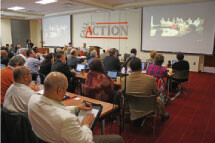
Global Call to act goes forth
BY MELISSA LAUBER
UMCONNECTION STAFF
 The United Methodist Church is standing at a threshold moment in its history – poised to address four decades of decline and a creeping crisis of relevancy in today’s world.
The United Methodist Church is standing at a threshold moment in its history – poised to address four decades of decline and a creeping crisis of relevancy in today’s world.
God has called the church to action and the church will respond, said Bishop John Schol, leader of the Baltimore-Washington Conference.
On April 6, 125 BWC leaders joined with 1,000 other groups from across the world to address the future of the denomination in an interactive satellite broadcast Leadership Summit.
The Call to Action, which drew the leaders together, focuses on a study conducted by Towers and Watson that did extensive research on the denomination. As part of the study, they examined nearly 33,000 churches in the United States and discovered 5,000 of them showed healthy signs of vitality. The 16 factors they all have in common, were labeled "drivers of vitality." These drivers center around small groups, lay empowerment, clergy effectiveness and worship.
The study also called for several systemic changes in the denomination, including:
+ Focusing, for at least 10 years, on growing the number of vital congregations, in part by employing statistical measures for tracking key performance areas;
+ Reforming the Council of Bishops to emphasize accountability for ministry results;
+ Improving and aligning the process for identifying, training, credentialing, appointing and evaluating clergy leadership; and
+ Sharpening the focus and reducing the costs of General Agencies.
"We must change our mindset and practices so that our primary focus and commitment is on creating and sustaining congregational vitality," Bishop Schol said. "The Call to Action gives us the makings of a road map."
During the summit, five leaders from the denomination’s Call to Action steering team reported that the "the status quo of a shrinking and aging U.S. church is ‘toxic’ and unsustainable."
Led by Bishop Larry Goodpaster, president of the Council of Bishops, they introduced an "adaptive challenge" for the church that will "redirect the flow of attention, energy and resources to an intense concentration on fostering and sustaining an increase in the number of vital congregations effective in making disciples of Jesus Christ for the transformation of the world."
An adaptive challenge, Bishop Schol said, moves beyond a "technical fix," which has an immediate and known solution, and develops new solutions, answers and expertise to address an issue. "An adaptive challenge reframes the future."
On the Leadership Summit broadcast, steering team members offered their advice about how the adaptive challenge can be met. "In God’s mission we will have to learn new languages. We will need to learn to tell the Good News of Jesus Christ in ways that people who are not familiar with it can understand," said Bishop Rosemarie Wenner of Germany.
"As we go beyond our walls and comfort zones, we realize it’s not about us or the future of the denomination," said Bishop Gregory Palmer of the Illinois Area. It’s about God, who loves the world so much he gave his son, about Christ in whom the Word of God became flesh and the Holy Spirit who renews the world and transforms it."
Ben Boruff, a young adult member of the steering team, and Erin Hawkins, general secretary of the General Commission on Religion and Race, challenged the church to reach out to and bring in new people.
"When we look at the future of The United Methodist Church, it’s one that requires us to take a serious look at how we extend ourselves into a world in a world that doesn’t look like the average United Methodist," Hawkins said. "Unless we are willing to make the things we consider special interests the main interest or at least equal interest, I think we won’t find ourselves much further down the road."
As part of the summit, participants who gathered at the more than 1,000 meeting places broke for conversation to respond to questions that the Council of Bishops will use to shape future actions surrounding the Call to Action.
Within the Baltimore-Washington Conference, people spoke candidly about their hopes for the church and the challenges facing United Methodists.
Some of the participants questioned the motivation of the Call, expressing hope that this new movement, which is expected to draw upon the denomination’s resources for the next 10 years, is being done to "build the Kingdom and not preserve an institution."
Others stressed the importance that the resources to create vitality and the measures being taken to assess faithfulness and fruitfulness will be "contextual," taking into account the setting in which each church finds itself.
Based on the feedback received from the Summit and from the 513 questions viewers sent electronically to the steering committee, a plan to equip local churches to grow in vitality is being developed.
Within the Baltimore-Washington Conference, Bishop Schol said, a planning guide for every church has been created in which local churches assess key factors for the past three years and set goals for the next four years.
Among the factors churches will measure are worship attendance, professions of faith, giving, mission engagement and small group involvement. The BWC already leads the denomination in compiling all of these indicators, except for small group involvement.
From the figures, churches will create a vision for vitality. These plans will be gathered from every local church and presented as a gift from the Baltimore-Washington Conference to the 2012 General Conference.
This planning tool and more about the Call to Action will be launched this fall and celebrated at Charge Conferences.
Are we willing to change, the bishop asked. "No person or group has all of the answers. But we all have a piece of the answer."
A video of the Leadership Summit is available online at www.umc.org.

Login/Register to leave comment